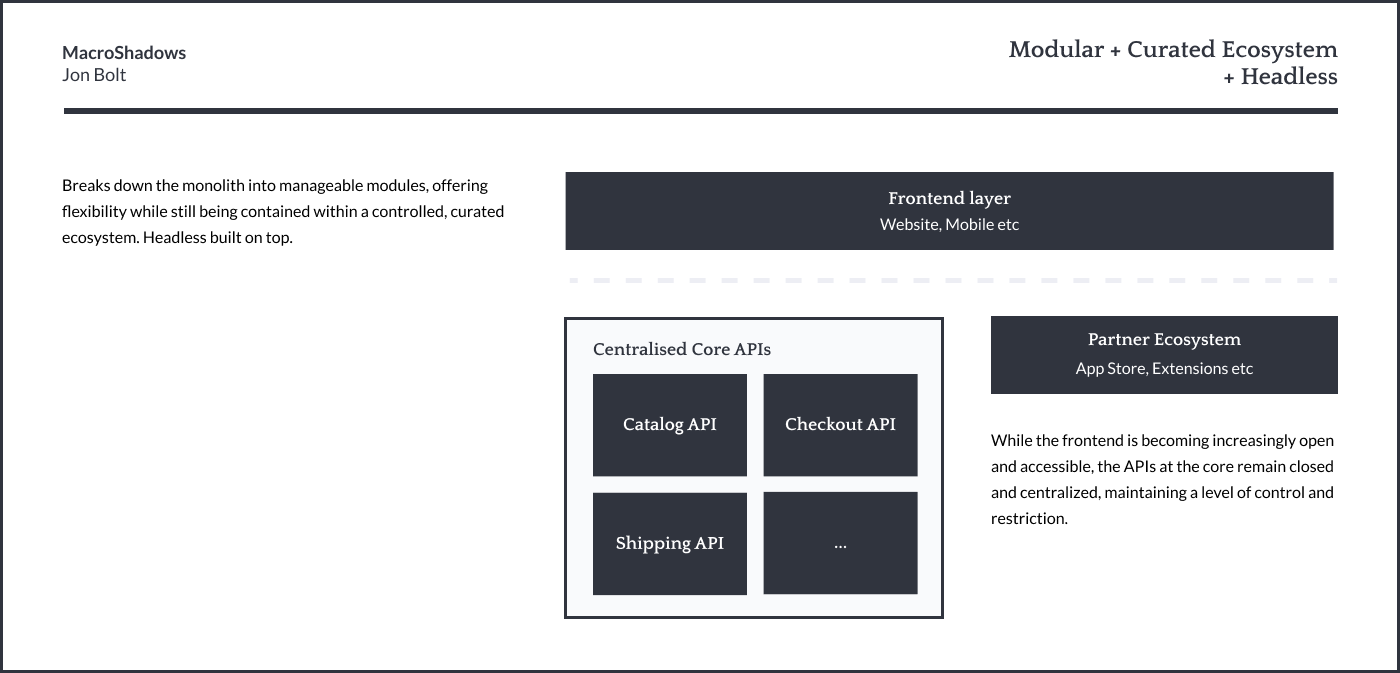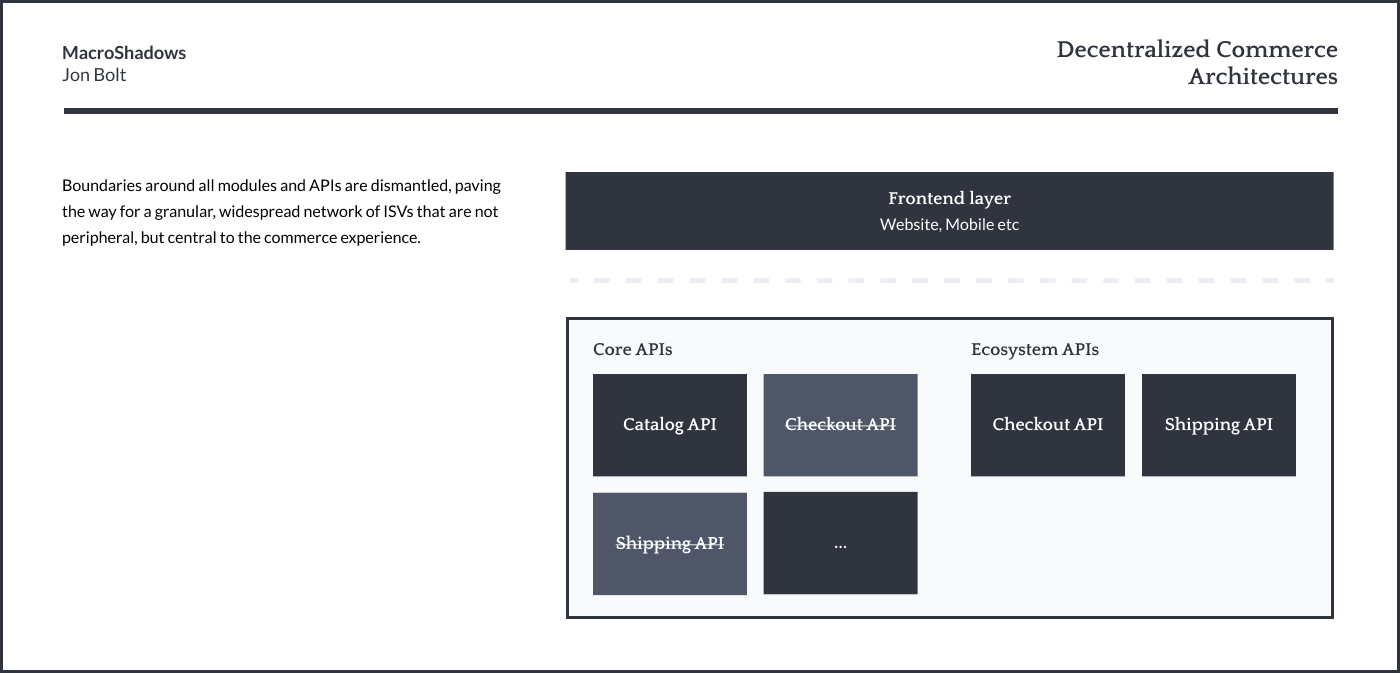The ecommerce SaaS landscape has evolved from monoliths to modular systems, now embracing headless and MACH architectures. However, remnants of monolithic structures are hidden beneath the surface of these advanced frontends. This article unveils and explores these concealed elements
In the not-so-distant past, the commerce landscape was firmly in the grip of monolithic, centralized architectures. Ecommerce platforms, with their all-encompassing designs, presented a one-size-fits-all solution, marked by rigid boundaries and limited flexibility.
From monolithic to modular
The emergence of the modular + curated ecosystem model offered a semblance of evolution:
- Modularity: The shift towards modularity was helpful, but often amounted to a commercial repositioning or an internal technical overhaul rather than a fundamental transformation. Monolithic systems were segmented into more manageable, granular parts, improving manageability but not addressing the core limitations. The transition from this modularity to true composability — characterized by seamless integration and the interchangeability of external components — remained an elusive goal, a gap yet to be bridged.
- + Curated ecosystems: Commerce platforms began opening their doors to third parties through App Stores, offering extensions and enrichments to the native feature set. However, this wasn't as revolutionary as it seemed. It was a limited expansion, an augmentation of the core. The curated App Stores, though a step forward, were closely guarded territories. The platforms held the keys, and access was granted selectively, often with stringent restrictions. A case in point is Shopify’s abrupt decision to block third-party checkout apps, a move that underscored the persistent control exerted by the core platform.
Armchair Quarterback of Back-Office SaaS
To explain my perspective - I'm the founder and CEO of Onport, a B2B SaaS platform that specializes in automating back-office operations like catalog, orders, and inventory for marketplaces. Humbled to have some incredible marketplaces operating on our platform.
Our acquisition by Farfetch in 2021 marked a significant milestone, but also provided a vantage point on the frontend space, with our subsequent expansion into the enterprise market. We're positioned somewhat agnostically, interfacing with both in-a-box solutions like Shopify and headless/composable platforms like ElasticPath, Saleor, and CommerceTools, as well as those bridging both worlds (e.g. BigCommerce). Deeply connected into the frontend, at times directly with the consumer (e.g. passing up live rates to the checkout). But, we're still a step back from the core frontend architecture.
While this might have an “armchair quarterback” ring to it, we’re deeply connected and reliant on the changes occurring in the frontend space.
Even though the modular + curated ecosystem platforms marked a step forward, it still imposes significant constraints, especially for those aiming to implement complex flows or nuanced experiences on the frontend. As an example, we often encounter the inability to facilitate intricate cross-border logistics and tax flows at checkout for marketplaces on their frontend platform of choice.
The core still maintained its significant, imposing footprint. The deep-seated lack of agility remained unaddressed; the solutions were surface-level, offering more of a patch than a fix.
Re-platforming emerges as the sole recourse, akin to demolishing the house just to change the curtains. Each attempt to advance is met with new, unforeseen limitations - a cycle of construction and demolition.
The rise of MACH
MACH (microservices, API-first, cloud-native SaaS, headless) has been a welcome catalyst for change. Decomposing the monolithic structures, breaking them down into granular, focused components that power rich, dynamic frontend experiences. It’s a shift from rigidity to flexibility, enabling retailers to craft bespoke commerce experiences, tailored and responsive.
For those of us seasoned in the tech space, there’s an ingrained skepticism towards trends, especially those encapsulated in acronyms. However, the emerging network of system integrators and SaaS/ISVs adopting and evangelizing this approach is credible. It's a win for retailers/marketplaces, for consumers and for entrepreneurs looking to find value and build new ventures.
This evolution from modular to composable has unlocked new possibilities. Our marketplaces can now easily swap out core components of the frontend architecture to accommodate complex, nuanced requirements. It’s a level of adaptability and customization that was previously unattainable. For us at Onport, it means deeper connections into the core, enabling a level of influence and adaptability that caters to the complex requirements on the frontend that marketplaces need
Moreover, for us and others who operate back office platforms behind the frontend, the advent of MACH signifies a departure from the confines of curated app stores.We’re no longer on the periphery, navigating the restrictions and boundaries set by the commerce platforms. The gates have been flung open. We’re now integral players, actively participating and contributing to the core, shaping and enhancing the commerce experience in real-time.
You got MACH’d
However... there’s a particular nuance in the shift towards MACH-oriented architectures that I believe is overlooked. The modular + curated ecosystem players adding headless to their mix, then flying the banners of composability. The playbook goes something like this:
✅ M - Conflate modularity and microservices, and you’re in.
✅ A - With curated ecosystems, robust API support is a given.
✅ C - Likely already cloud-native. Check.
✅ H - Introduce headless features, and voila, MACH achieved.
The real issue lies with the 'M'. It’s not about the intertwining of modularity and microservices. Even if platforms under the modular + curated ecosystem umbrella transitioned from modules to independent microservices, a barrier still exists around those services. These services, while toggleable, are not replaceable.
Viewed from the back office, commerce platforms that tread this path bear a striking resemblance to their monolithic predecessors. Wolves in sheeps clothing, where modularity and microservices are masquerading as composability.

Progress, yes, but it still leaves us within confined boundaries, a walled garden at the core of these platforms. A perspective I find helpful in handling this misconception, is viewing and assessing these frontend platforms through a perspective of decentralisation - Decentralized Commerce Architectures.
Decentralized Commerce Architectures
Ecommerce platforms venturing into this terrain are relinquishing control of modules once deemed sacrosanct to the monolith - search, payments, catalog management. In this relinquishment, and the move towards a more decentralized architecture, they are unlocking the composability needed to drive complex commerce experiences for the consumer and flows of data for the retailer/marketplace.
This challenges the traditional playbook advocating for expansive footprints in tech, where the breadth of features and functionalities defined the platform’s value. In the Decentralized Commerce Architecture world, this narrative is flipped.
Network of ISVs should not just emerge on the periphery of the stack, but in the core. Dismantling the boundaries around modules and decentralising control. The greater level of decentralisation, the more granular and widespread the network of ISVs can become and the subsequent level of innovation. To help us differentiate:
Modular + Curated Ecosystems + Headless: These are still akin to gated communities. There’s a semblance of diversity and flexibility, but it’s within the confines of predefined boundaries. The core remains intact. It’s an environment of controlled participation.
Decentralized Commerce Architectures (DCA): The core is decentralised and becomes a playground for innovation. Boundaries around all modules are dismantled, paving the way for a granular, widespread network of ISVs that are not peripheral, but central to the commerce experience.

Summary
The journey towards true composability in frontend commerce platforms can be assessed by examining their progression towards decentralized commerce architectures (DCA). Decentralization serves as a critical metric, distinguishing frontend platforms that have embraced true composability from those maintaining centralized control over their core architecture. While Modular + Curated Ecosystems + Headless platforms signify a notable advancement, the real differentiation is found in the nuances of core accessibility and control.
As the market evolves, the impact of these shifts will become clear. The willingness of platforms to embrace decentralization and relinquish centralized control marks a departure from traditional norms. It's a contraction, yet one that holds the promise to push us forwards into a new era of innovation and flexibility.
